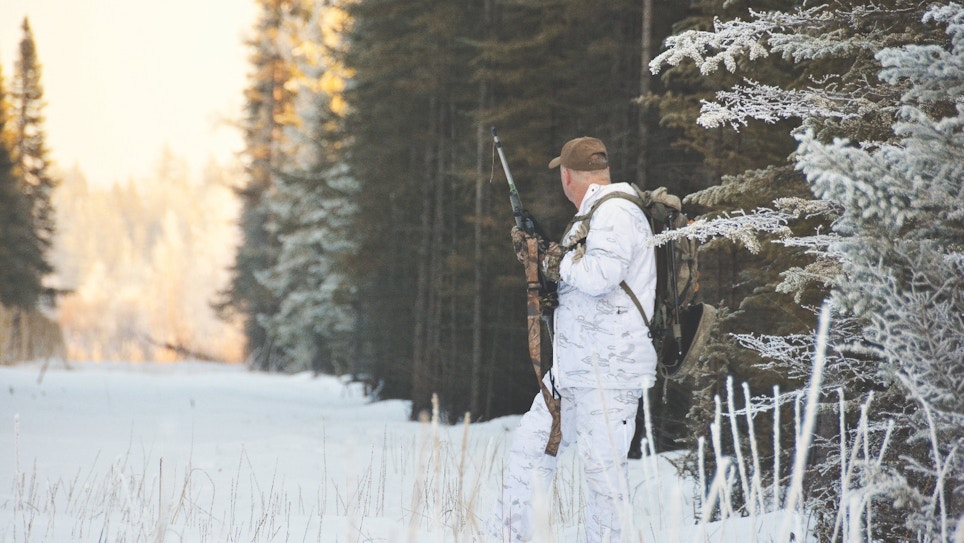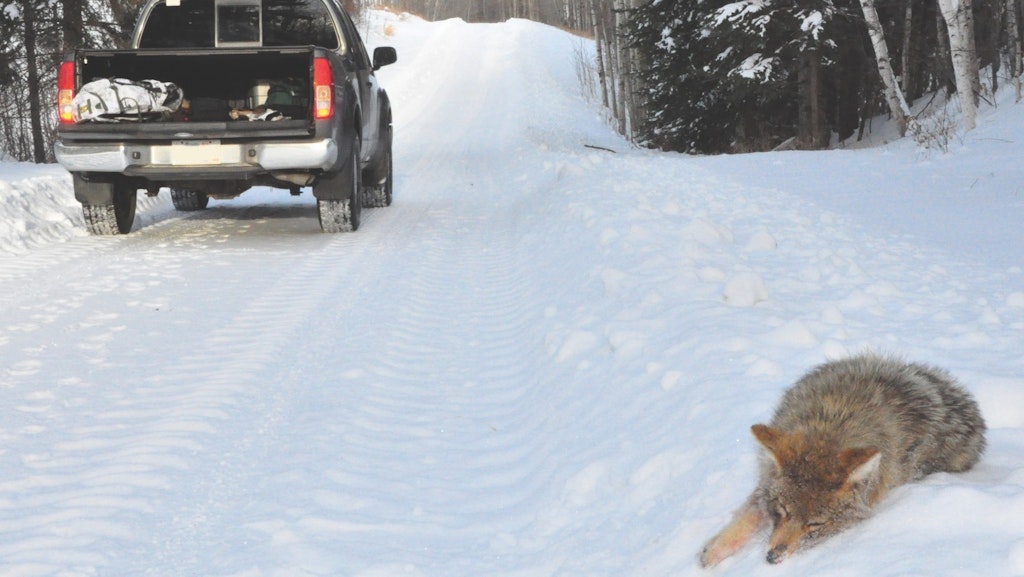There’s little doubt that I kill most of the coyotes I take every year by either calling or waiting for them in ambush. But aside from these two techniques, my third most successful method isn’t a method at all. These are simply the unexpected coyotes I blunder into when I’m either walking or driving, trying to get somewhere I need to be. I call them bonus coyotes, and there’s enough of them every year that they add up.
I’ll be the first to admit it, I live in an area with an abundant coyote population. And lots of coyotes make blundering into them much easier. But I’m convinced every predator hunter does it occasionally and so the lessons I’ve learned, usually the hard way, should help others. Here’s how I break down these encounters and some tricks that work for each of the three categories.
When on Foot
Like most predator hunters, I drive to where I want to hunt, hide the truck and then take my rifle for a walk, hoping I’ll execute a successful strategy of calling or ambushing. The length of those walks varies widely, but one thing that never changes is the possibility of blundering into a coyote while hoofing it to where I want to hunt, or while trudging back to the truck.
I learned long ago to keep my head up and my eyes scanning the terrain for coyotes that are also on the move. A recent encounter provides a great example. As a buddy and I hiked to a calling stand, a coyote abruptly trotted out of the brush filled fence line we were following and into the open field. All three “predators” saw each other about the same time, with the coyote quickly running off some distance before stopping to look back. By then I had already eliminated the possibility of a prone shot because of high crop stubble, therefore I’d snapped my bipod onto the rifle and was already down on one knee using the bipod for support. When the coyote stopped, I guesstimated the range at 300 yards and downed him with a quick shot.
The entire episode took less than a minute and is a great example of why it’s important to always keep your rifle and support system available for a quick, unexpected coyote encounter. My only concession to that rule is to walk with an empty chamber, but then it doesn’t take long to cycle the bolt if the magazine is loaded. Bipods that are quick to attach and deploy, such as the Spartan system, are a huge help because the shots are often long.
While the above is a simple, straightforward encounter, sometimes it gets more complicated, like the two springtime coyotes my young friend Wes took this past year. We were hunting a brand-new property and while walking across an open field in search of a calling site, several coyotes appeared in an adjoining field far more than a reasonable rifle shot away. Fortunately, we spotted them first and quickly crouched down, because there was nowhere to hide. We were caught completely in the open, at a distance where a successful shot wasn’t realistic and with a wind not suitable to try calling them, so we tried a trick I’ve successfully used in the past.
While in full view of the coyotes, we simply went for a long shuffle on our hands and knees. The coyotes spotted us immediately but weren’t overly alarmed because we didn’t have the classic biped shape of those dangerous humans they are so familiar with. At the distance we were from the coyotes, I’m sure we looked more like the cows they share the land with. It was a long walk/crawl to a fence line where we took a break and reassessed the circumstance we were in. As I’d hoped, the coyotes were still mousing in their field, just giving us an occasional wary look.
We were now in a position where a little calling could move the coyotes into place for a shot, so while I worked a mouth call, Wes worked his .223 at 171 and 240 yards, resulting in two less coyotes to harass the rancher during the upcoming calving season. I’ll hunt that property differently now that I know where the coyotes hang out, but the story is a great example of how stumbling into coyotes and a little creative strategy can turn a blunder into a successful encounter.
When on Wheels
Blundering into coyotes isn’t done exclusively on foot. Spotting one or more coyotes out in an open field while driving is common in my part of the world. Often, they are mousing or scavenging for food, and just as commonly they are like me and traveling to somewhere they need to be. They are universally aware that a moving truck is no danger to them, and they’ll keep on doing whatever is occupying their life while keeping a suspicious eye on that vehicle. However, if the truck stops, they know the occupants will soon start throwing bullets their way and so they quickly shift into high gear and vacate the area. This little slice of local reality regulates how I handle these bonus coyotes.
Shooting from or across a publicly maintained road is illegal in my jurisdiction, adding an additional layer of complexity. This means my favourite method of handling these “road-spotted” coyotes is done when I’m hunting with a buddy.
Typically, we’ll spot a coyote in a field too late to execute a plan of any kind, so we simply keep driving until we’re out of sight. Then we turn around and set up so the passenger is ready to bail out of the truck, preferably on the side of the vehicle opposite the coyote, as the truck again drives by and slows/stops enough to let the shooter out. As the shooter bails, the driver accelerates and the shooter melts into the weeds and/or snow in the ditch.
The coyote, of course, goes into full alert as the vehicle slows and might even start running, but as the truck leaves, its alert and activity level immediately drops back down to normal. Then it’s simply a matter of the shooter navigating to the edge of the roadway’s right-of-way where it’s legal to deliver that accurate shot needed.
Of course, there’s no way this works when hunting alone, although I am hopeful self-driving vehicles will someday be able to drop me off, go hide, then come back and pick me up. Until then, when I’m alone my best technique is to do a quick evaluation of the terrain, keep driving to somewhere I can hide the truck, then do a foot approach based on wind, terrain and available cover. I might not get into rifle shot range, and if that’s the case staying downwind and calling might just do the trick.
Then there are the times I encounter bonus coyotes while driving across pastures or along two-tracks not governed by our “no shooting from the road” laws. In these situations, I find it’s rare to be able to use the drive-by and drop-off technique. Instead, it’s a matter of bailing out of the truck and shooting as fast and as accurately as possible. We are still governed by “no shooting from inside the vehicle” legislation, which makes getting out with a rifle and using whatever support is available an important skill set.
A recent situation like this occurred when I was hunting on a large ranch. While driving down a ranch road, I broke out of some trees into a large pasture, and there ahead of me a pack of four coyotes was also passing through the pasture. There were no other options, and these coyotes knew a stopped truck meant lead in the air, so they headed for safety. I was able to bail out quickly, use a handy fencepost for support and drop the last one in the line. My efforts were aided by the deep snow in that field and the difficulty those coyotes had in maintaining a full run.
Later that day I ran into the landowner and he told me how I should have been with him that morning as he spooked a pack of four coyotes out of his cows. As he told me the tale, and where it happened, I realized these were the same four I’d encountered. “I got one of them,” I said, explaining how things had worked out. He was extremely pleased, and I earned enough points to ensure continued hunting on his property.
When Preoccupied
Sometimes it’s not the hunter who blunders into the coyote, but the other way around, making it worthwhile to be prepared for those encounters as well. A good example is the time I take to field skin most of the coyotes I harvest. Rather than take them on a long drag back to the truck, I find it’s easier to quickly hang them from a handy tree and peel the hide off. That way I don’t have carcasses to deal with at home, there’s 25 less pounds to lug back to the truck and the local crows and ravens get a feast. Everybody wins. Especially when I discipline myself to look around regularly while I’m skinning. I’ve lost count of the number of coyotes that have wandered by while I was field skinning and thus got added to the count, simply because they blundered into me. If I’m hunting with a buddy, I’ll usually delegate the watching role to him, ensuring we have at least one rifle safely out of the way, but ready to go at a moment’s notice.
This past winter it happened again. This time I was hunting with my son-in-law, and I’d parked in a pasture in anticipation of doing a stand at the far end. We were at the back of the truck, with the tailgate down, getting our gear ready for a hike when a coyote walked out into the open about 230 yards away, oblivious to our presence. My son-in-law had his rifle in hand already, so I hissed, “Coyote,” and pointed. He dropped to one knee, grabbed some support from the tailgate and dropped the coyote with a single shot about the same time it seemed to first notice the truck.
No matter what you’re doing in coyote country, it pays to keep alert for those times when a coyote blunders into the hunter. I’ve had it happen when field skinning, eating lunch, catching up on emails, as well as when getting ready to leave, or returning to the truck.
Commonalities
However it happens, blundering into unexpected coyotes is always hugely entertaining and exciting. The principles required to turn these events into successful hunting stories includes the ability to shoot quickly and accurately from improvised positions. It’s why I regularly spend some range time during the off-season replicating and shooting from less-than-usual positions. These include using posts or trees for support, kneeling and a rapid prone position.
Another principle to successfully take blundered coyotes is some ability to judge ranges without the use of a laser rangefinder. Most of the coyotes I take in these situations are shot at 200 to 300 yards with no time to utilize this device. That makes rapid range estimation using nothing but eyeballs an important skill.
And the last principle is the ability to make quick tactical decisions based on the circumstances of the encounter. Unfortunately, the only way to get really good at this is through experience, which means that over the years, there will be lots of coyotes that escape. When this happens, it’s OK. An education is rarely free and here the price we pay is failure. While there will be a lot of it initially, in time, blundering into coyotes will become a regular method of adding several extra furs to the winter’s take.







